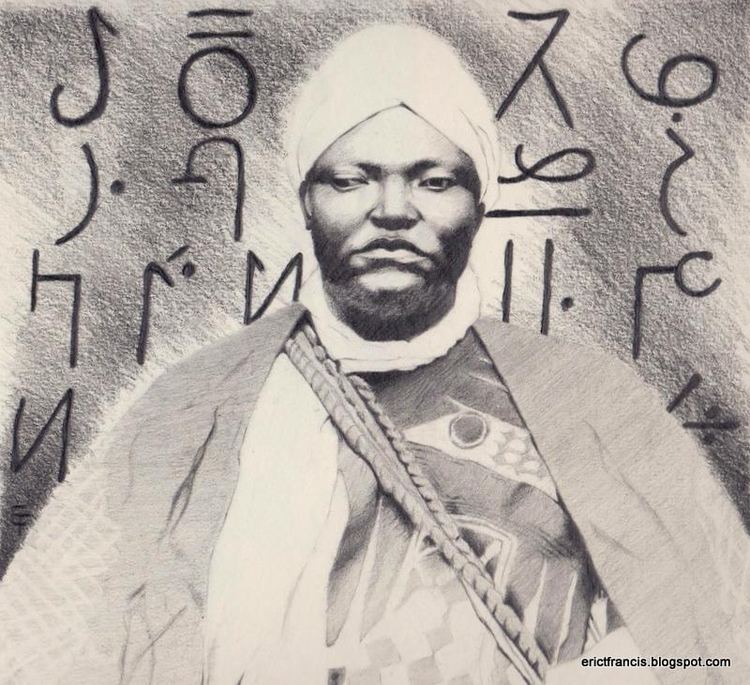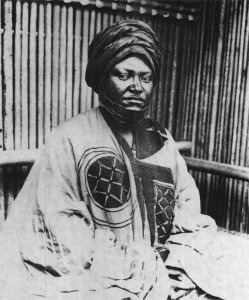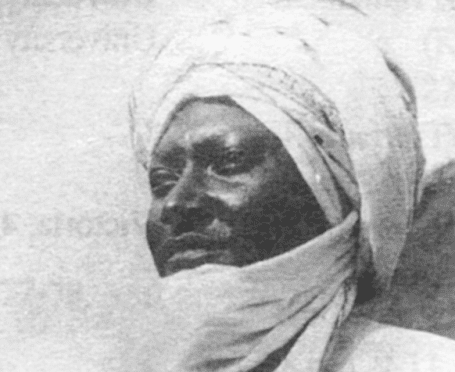Name Ibrahim Njoya | ||
 | ||
Ibrahim njoya le roi des bamoun
King Ibrahim Mbouombouo Njoya (Bamum: ꚩꚫꛑꚩꚳ ꛆꚧꛂ - , occasionally spelled as Njoja) c. 1860 – c. 1933 in Yaoundé, was 17th in a long dynasty of kings that ruled over Bamum and its people in western Cameroon dating back to the 14th century. He succeeded his father Nsangu, and ruled from 1886 or 1887 until his death in 1933, when he was succeeded by his son, Seidou Njimoluh Njoya. He ruled from the ancient walled city of Fumban.
Contents
- Ibrahim njoya le roi des bamoun
- Do You Know King Ibrahim Njoya
- Person and life
- Rule
- Innovations
- References

Do You Know King Ibrahim Njoya?
Person and life

Colonel Gorges of the British Army, who met him in 1914, described him thus: "A fine upstanding man, not very negro in type, dressed in blue robes and wearing a turban with the end tied under his chin and over his mouth." He practised polygamy — Gorges reported that he had 600 wives and 149 children by 1915; it is thought that he had 177 children in all.
Rule

Njoya's mother, Njapdunke, acted as regent until he reached majority. His official rule was further delayed because his father's head was held by an old adversary, the Nso people. (By tradition the head or skull of an ancestor is of ceremonial importance to the Bamum.) The Germans helped him in recovering the head and this, along with their allowing him relative independence, caused him to have generally good relations with them. Since the German colonizers after taking possession of Cameroon and were advancing inland, the young King Njoya developed a strong interest in the culture of the new "fatherland". An additional factor seems to have been a belief that fighting the Germans would prove counterproductive to his people, hence he rejected the resistance proposals of Rudolf Duala Manga Bell. He greeted the Germans with great celebrations in his residence in Foumban , which soon brought him the title of an official figure-holder of the German colonial government. King Njoya tried to maintain a good relationship with the German Empire during his lifetime. On the birthday of Kaiser Wilhelm II, he had given him the throne from the governor of Buea. This put Njoya in the Kaiser's favor, and enabled Felix von Luschan, director of the Berlin Museum of Ethnology, to exhibit the throne, which had been imprinted with dyed pearls in great skill. To this day the throne can still be seen in the Berlin Ethnological Museum. In return Wilhelm II sent for, as he put it, his königlichen Bruder (royal brother), a German Cuirassier uniform of the German Imperial Guard. Like an oil painting of Wilhelm II, the uniform is now exhibited in the Palace Museum at Foumban.

Njoya was convinced that German and Bamun culture are compatible. In cooperation with the German administration, he set up schools in which the Bamun children extended their knowledge of their mother tongue, learned the Bamun script introduced by Njoya, and also passed on basic knowledge of the German language.

Col. Gorges noted in 1914 that he held court or durbar daily outside the gatehouse for the dispensing of justice and receipt of tribute, and that all his people had access to him. There was a very well-defined code of court etiquette observed.
"Any courtier wishing to speak to him assumes a cringing attitude, removes his skull-cap, clasps his hands and, taking a chukker round behind the presence, finally arrives at the royal elbow. Here he averts his head and makes his request in a hoarse whisper. When the king coughs or clears his throat everyone present softly claps his hands."
In 1917, Njoya demolished the old palace built in traditional wooden architecture of the Bamun and built a new residence in Prussian brick style in its place.
In 1916, the French had taken control of German Cameroon, and the Kingdom of Bamun lost its partial autonomy. Since Njoya resided in Foumban until 1931, despite his formal abolition by France, he had, in a de facto sense, still had assumed the role as the king. Also in 1931, he was sent to Yaoundé, where he died two years later in 1933 at the age of 66. His successor was Seidou Njimoluh Njoya.
Innovations
Ibrahim Njoya is credited with developing the Bamum script, a semi-syllabic system for writing in the Bamum language. Before his reign, the long history of the Bamum people was preserved primarily through oral transmission from one generation to the next in the manner of the African Griot tradition. (This was largely true of many other African civilizations of the time.)
Recognizing the inherent danger of important historical facts being omitted or corrupted, he set out to establish a means of written recording of Bamum history. When his work was completed, his alphabet, called, A-ka-u-ku based on its first four signs, contained 73 signs in total.
Njoya may have also invented a hand-powered mill for grinding corn and other cereals.
After initially starting the project in the 1980's, his grandson, Ibrahim Mbombo Njoya, a present-day Sultan in Cameroon and the latest ruler in the Bamoun Dynasty, has continued the transition of the palace into a museum, in which schoolchildren are learning the Bamum script developed by Ibrahim Njoya.
